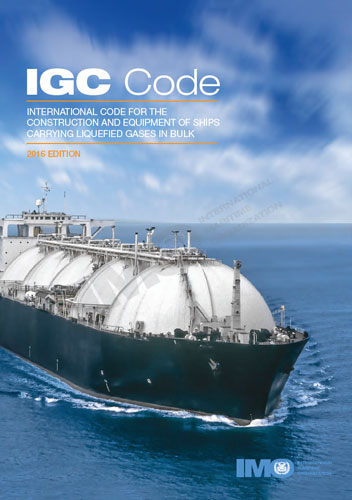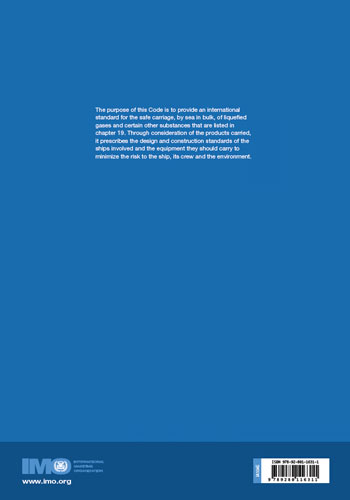IGC Code International Code for the construction and equipment of ships carrying liquefied gases in bulk/Международный кодекс постройки и оборудования судов, перевозящих сжиженные газы наливом (Кодекс МКГ)
Издание на английскоя языке
См. также Международный кодекс постройки и оборудования судов, перевозящих сжиженные газы наливом (Кодекс МКГ) резолюция MSC.370(93). International code for the construction and equipment of ships carrying liquefied gases in bulk (IGC Code) resolution MSC.370(93) (4-е издание, исправленное)
At its forty-eighth session (June 1983), the Maritime Safety Committee (MSC) of the International Maritime Organization (IMO ) adopted amendments to the International Maritime Convention for the Safety of Life at Sea, 1974 (SOLAS), by resolution MSC.6(48).
The amendments consisted of complete replacement texts of chapters III and VII and changes in chapters II -1, II -2 and IV.
The new chapter VII made the provisions of the International Code for the Construction and Equipment of Ships Carrying Liquefied Gases in Bulk (IG C Code), which was adopted by resolution MSC.5(48), mandatory under the 1974 SOLAS Convention.
The new 2016 edition of the IG C Code incorporates the amendments adopted by the MSC at its ninety-third session (May 2014) by resolution MSC.370(93). These amendments, which entered into force on 1 January 2016, consist of a complete replacement text of the IG C Code.
Unless expressly provided otherwise, the requirements of the IG C Code, as amended by resolution MSC.370(93), apply to ships whose keels are laid, or which are at a similar stage of construction, on or after 1 July 2016.
For ships constructed on or after 1 July 1986 and before 1 July 2016, unless expressly provided otherwise, the Administration shall ensure that such ships comply with the requirements which are applicable under the IG C Code, as adopted by resolution MSC.5(48) and as amended by resolutions MSC.17(58), MSC.30(61), MSC.32(63), MSC.59(67), MSC.103(73), MSC.177(79) and MSC.220(82).
Contents
Foreword
Preamble
Resolution MSC.5(48)
Resolution MSC.370(93)
Chapter 1 General
1.1 A pplication and implementation
1.2 Definitions
1.3 Equivalents
1.4 Surveys and certification
Chapter 2 Ship survival capability and location of cargo tanks
2.1 General
2.2 Freeboard and stability
2.3 Damage assumptions
2.4 Location of cargo tanks
2.5 Flood assumptions
2.6 Standard of damage
2.7 Survival requirements
Chapter 3 Ship arrangements
3.1 Segregation of the cargo area
3.2 Accommodation, service and machinery spaces and control stations
3.3 Cargo machinery spaces and turret compartments
3.4 Cargo control rooms
3.5 Access to spaces in the cargo area
3.6 Airlocks
3.7 Bilge, ballast and oil fuel arrangements
3.8 Bow and stern loading and unloading arrangements
Chapter 4 Cargo containment
4.1 Definitions
4.2 Application
Part A Cargo containment
4.3 Functional requirements
4.4 Cargo containment safety principles
4.5 Secondary barriers in relation to tank types
4.6 Design of secondary barriers
4.7 Partial secondary barriers and primary barrier small leak protection system
4.8 Supporting arrangements
4.9 Associated structure and equipment
4.10 Thermal insulation
Part B Design loads
4.11 General
4.12 Permanent loads
4.13 Functional loads
4.14 Environmental loads
4.15 Accidental loads
Part C Structural integrity
4.16 General
4.17 Structural analyses
4.18 Design conditions
Part D Materials and construction
4.19 Materials
4.20 Construction processes
Part E Tank types
4.21 Type A independent tanks
4.22 Type B independent tanks
4.23 Type C independent tanks
4.24 Membrane tanks
4.25 Integral tanks
4.26 Semi-membrane tanks
Part F Cargo containment systems of novel configuration
4.27 Limit state design for novel concepts
Part G Guidance
4.28 Guidance notes for chapter 4
Chapter 5 Process pressure vessels and liquids, vapour and pressure piping systems
5.1 General
5.2 System requirements
5.3 Arrangements for cargo piping outside the cargo area
5.4 Design pressure
5.5 Cargo system valve requirements
5.6 Cargo transfer arrangements
5.7 Installation requirements
5.8 Piping fabrication and joining details
5.9 Welding, post-weld heat treatment and non-destructive testing
5.10 Installation requirements for cargo piping outside the cargo area
5.11 Piping system component requirements
5.12 Materials
5.13 Testing requirements
Chapter 6 Materials of construction and quality control
6.1 Definitions
6.2 Scope and general requirements
6.3 General test requirements and specifications
6.4 Requirements for metallic materials
6.5 Welding of metallic materials and non-destructive testing
6.6 Other requirements for construction in metallic materials
6.7 N on-metallic materials
Chapter 7 Cargo pressure/temperature control
7.1 Methods of control
7.2 Design of systems
7.3 Reliquefaction of cargo vapours
7.4 Thermal oxidation of vapours
7.5 Pressure accumulation systems
7.6 Liquid cargo cooling
7.7 Segregation
7.8 Availability
Chapter 8 Vent systems for cargo containment
8.1 General.
8.2 Pressure relief systems
8.3 Vacuum protection systems.
8.4 Sizing of pressure relieving system
Chapter 9 Cargo containment system atmosphere control
9.1 Atmosphere control within the cargo containment system
9.2 Atmosphere control within the hold spaces (cargo containment systems other than type C independent tanks)
9.3 Environmental control of spaces surrounding type C independent tanks
9.4 Inerting
9.5 Inert gas production on board
Chapter 10 Electrical installations
10.1 Definitions
10.2 General requirements
Chapter 11 Fire protection and extinction
11.1 Fire safety requirements
11.2 Fire mains and hydrants
11.3 Water-spray system
11.4 Dry chemical powder fire-extinguishing systems
11.5 Enclosed spaces containing cargo handling equipment
11.6 Firefighter’s outfits
Chapter 12 Artificial ventilation in the cargo area
12.1 Spaces required to be entered during normal cargo handling operations
12.2 Spaces not normally entered
Chapter 13 Instrumentation and automation systems
13.1 General
13.2 Level indicators for cargo tanks
13.3 Overflow control
13.4 Pressure monitoring
13.5 Temperature indicating devices
13.6 G as detection
13.7 Additional requirements for containment systems requiring a secondary barrier
13.8 Automation system
13.9 System integration
Chapter 14 Personnel protection
14.1 Protective equipment
14.2 First-aid equipment
14.3 Safety equipment
14.4 Personal protection requirements for individual products
Chapter 15 Filling limits for cargo tanks
15.1 Definitions
15.2 General requirements
15.3 Default filling limit
15.4 Determination of increased filling limit
15.5 Maximum loading limit
15.6 Information to be provided to the master
Chapter 16 Use of cargo as fuel
16.1 General
16.2 Use of cargo vapour as fuel
16.3 Arrangement of spaces containing gas consumers
16.4 G as fuel supply
16.5 Gas fuel plant and related storage tanks
16.6 Special requirements for main boilers
16.7 Special requirements for gas-fired internal combustion engines
16.8 Special requirements for gas turbine
16.9 Alternative fuels and technologies
Chapter 17 Special requirements
17.1 General
17.2 Materials of construction
17.3 Independent tanks
17.4 Refrigeration systems
17.5 Cargoes requiring type 1G ship
17.6 Exclusion of air from vapour spaces
17.7 Moisture control
17.8 Inhibition
17.9 Flame screens on vent outlets
17.10 Maximum allowable quantity of cargo per tank
17.11 Cargo pumps and discharge arrangements
17.12 Ammonia
17.13 Chlorine
17.14 Ethylene oxide
17.15 Separate piping systems
17.16 Methyl acetylene-propadiene mixtures
17.17 Nitrogen
17.18 Propylene oxide and mixtures of ethylene oxide-propylene oxide with ethylene oxide content of not more than 30% by weight
17.19 Vinyl chloride
17.20 Mixed C4 cargoes
17.21 Carbon dioxide: high purity
17.22 Carbon dioxide: reclaimed quality
Chapter 18 Operating requirements
18.1 General
18.2 Cargo operations manuals
18.3 Cargo information
18.4 Suitability for carriage
18.5 Carriage of cargo at low temperature
18.6 Cargo transfer operations
18.7 Personnel training
18.8 Entry into enclosed spaces
18.9 Cargo sampling
18.10 Cargo emergency shutdown (ESD) system
18.11 Hot work on or near cargo containment systems
18.12 Additional operating requirements
Chapter 19 Summary of minimum requirements
Appendices
Appendix 1 IG C Code Product Data Reporting Form
Appendix 2 Model form of International Certificate of Fitness for the Carriage of Liquefied Gases in Bulk
Appendix 3 Example of an addendum to the International Certificate of Fitness for the Carriage of Liquefied Gases in Bulk
Appendix 4 N on-metallic materials
Appendix 5 Standard for the use of limit state methodologies in the design of cargo containment systems of novel configuration




